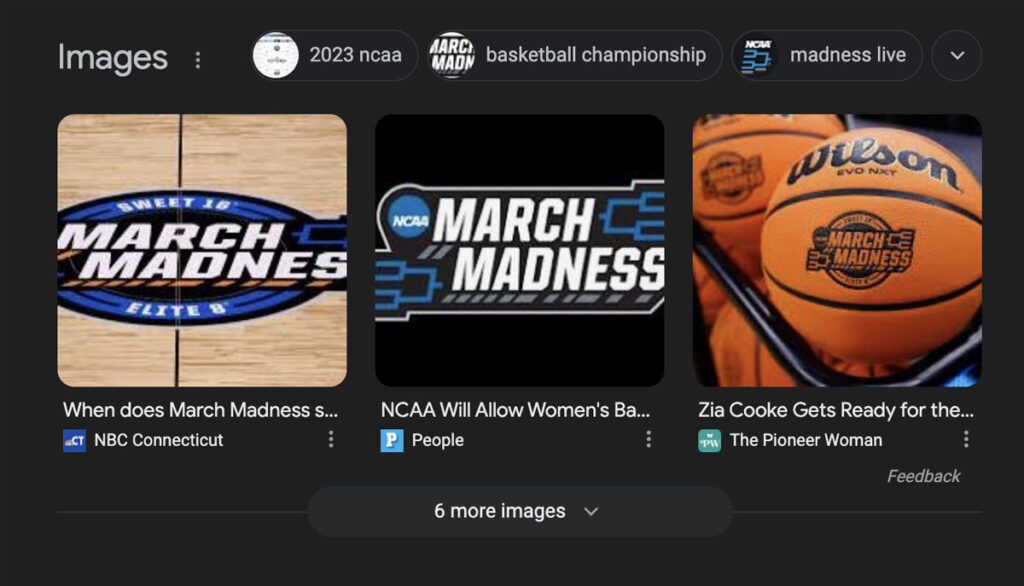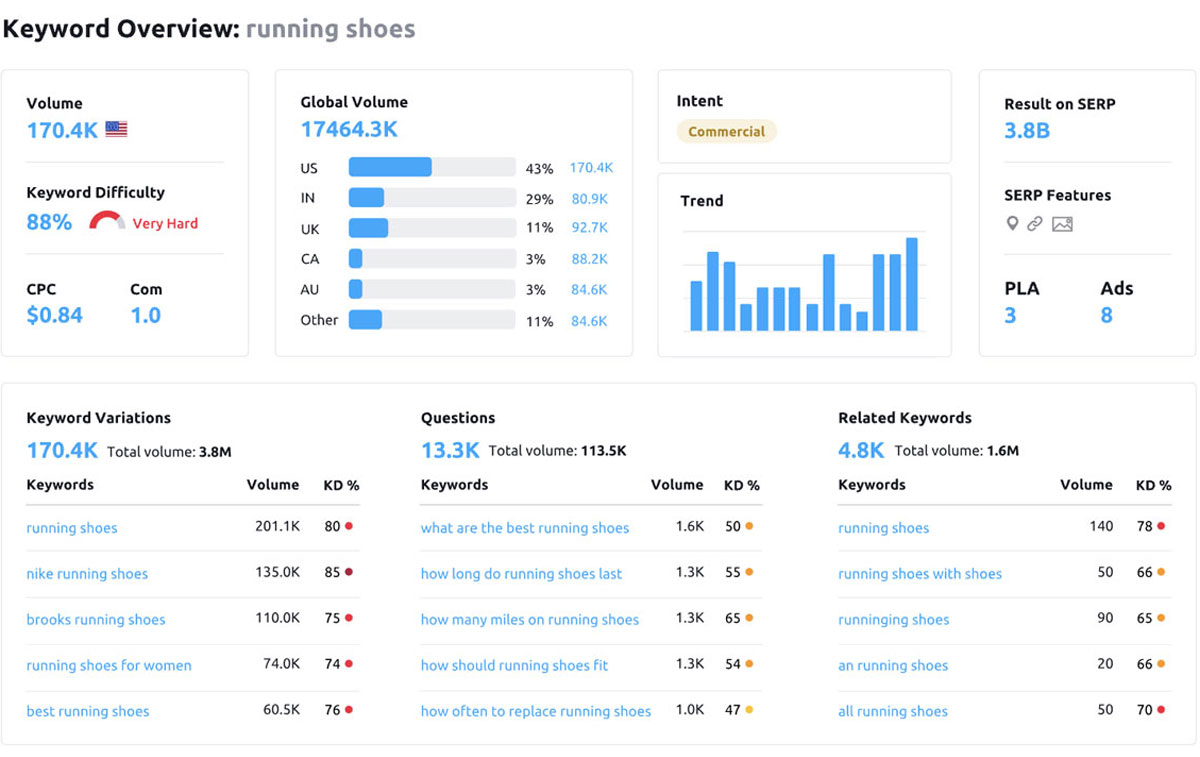When did you last click the “More Results” button at the bottom of a Google search? Not recently, right? Neither have we. That’s because Google’s search capabilities constantly improve and adapt to new information, trends, and what people want to see. Rarely do we need more results; we’ve already found what we’re looking for.
Here’s what it looks like, in case you’ve never ventured this far down the page:

Ranking highly on Google and other search engines is critical for your audience to find your brand and for you to share your products, services, and expertise with the world. But how to get into the coveted “Top 10” on search is more formulaic than it may seem at first glance. The key to the formula is Search Engine Optimization (SEO). Your goal with SEO is to optimize the content on your website such that it ranks highly on Google, therefore driving traffic to your website – talk about a virtuous cycle for your brand!
Cramming all the information about SEO into a single article is quite daunting. There are entire courses dedicated to the subject, so we will break it down into the fundamental best practices that have the greatest impact on your brand’s SEO success. Starting your SEO journey with keywords is the best approach, so that’s what we will focus on today.
Why Do You Care About SEO?
We’ve already covered the increased visibility and traffic to your website that comes with a solid SEO strategy, but what other benefits are there to tackling this project?
- The traffic to your website is targeted: Those visiting your site choose your link based on what they are already searching for.
- You’re gaining credibility and building trust: Higher-ranking sites are perceived as more credible, building trust in your brand.
- It’s non-paid advertising: You may invest in an SEO expert to help develop and execute your strategy initially, but this does not necessarily require ongoing investment. Once you rank highly, you will continue attracting organic traffic to your site.
- It’s a competitive advantage: Ranking higher than your competitors will drive more traffic to your site than theirs.
- Your entire digital presence benefits: A thoughtfully executed SEO strategy improves your website’s structure, content, navigation, and overall user experience.
Now that you know why we’re focusing on them, it’s time to dive into the SEO keyword best practices.
Best Practice 1: SEO Keyword Optimization
The core of SEO is driven by keywords or key phrases. Users search for these words or phrases during their customer journey, and you want to ensure that they find what they are looking for on your site. SEO search words are crucial in helping search engines understand the relevance of a web page to a user’s query.
But not all keywords are created equal. Determining the optimal keywords to help drive customers to your site is the magic sauce. The factors that make a great keyword or keyphrase can vary depending on the customer journey; however, some things to consider are:
- Length: Keywords can be a single word or close to a complete sentence. Often, longer, more specific phrases (long-tail keywords) are more effective for SEO. They’ll have a lower search volume but often have higher conversion rates because they are more specific.
- Relevance: A great keyword or keyphrase is highly relevant to the web page’s content and accurately reflects what users search for. It should align with the page’s topic, theme, or focus.
- Intent: This one can sometimes be tricky to decipher. Consider the user’s intent behind the keyword or keyphrase. Are they seeking information, products, services, or answers to specific questions? Choose keywords that match the intent of your target audience and align with your business objectives.
- Language: Your SEO keywords need to resonate with your target audience. Use the language they would use. A technical engineer searching for a product will use different search terms than a mother searching for a recipe. It’s also essential to think about synonyms and include them in various ways to capture related ideas.
- It Takes Time: SEO can take time to build up the credibility and content to rank highly. So consider your content long-term. Don’t chase short-term trends or fads unless they align with your content strategy and audience interests, which could mean updating content often.
Best Practice 2: SEO Keyword Research
Like any solid strategy, SEO requires research. However, you can optimize your time and effort if you have the right tools and processes in place.
Keyword Targeting for Your Audience
To conduct effective keyword research, it is essential to start by defining your target audience. This includes understanding their demographics, interests, preferences, and behaviors to create detailed buyer personas. It is important to consider how they speak and their language when searching for information about your products or services. Once you clearly understand your target audience, the next step is to identify where they are in their customer journey. Are they in the awareness, consideration, or decision stage? This information will help you tailor your keyword research to meet their needs and expectations at each stage of the journey.
To get insights into what your target audience is looking for, try conducting surveys and interviews, or analyzing customer feedback. This will help you understand their pain points and identify relevant keywords that address their specific queries. It is also helpful to analyze the keywords your competitors are targeting and how they are positioning themselves in the market.
SEO Keyword Analysis
Once you’ve brainstormed keywords through the lens of your ideal customer, you’ll need to determine how effective and valuable those keywords will be to your brand. Most tools contain a few key metrics that will help you analyze how valid your keywords are to a search engine.
- Search Volume: How often a keyword is searched. It represents the potential clicks you could get were you ranked highly in this keyword.
- Keyword Difficulty: Competitiveness of ranking for a keyword. A high difficulty means many sites already rank in this keyword, and breaking into that “Top 10” could be a mountain of a journey.
- Cost Per Click (CPC): Average dollars advertisers pay for a user’s click on an ad triggered by an analyzed keyword. Higher CPC means that brands are willing to pay for ads related to this keyword, which could make it more difficult to rank organically.
SEO Keyword Tools
It’s time to get down to the nitty-gritty. Here are some of our favorite tools to help your keyword research.
SEMrush

SEMrush has several tools (some free, some paid via subscription) to aid your research. These include the Keyword Overview Tool, where you can see the metrics mentioned above for a keyword you’ve brainstormed; the Keyword Magic Tool, which helps determine similar words and phrases; and the Competitive and Backlink Identifiers.
AnswerThe Public

AnswerThe Public provides keyword analysis, similar words or phrases to an entered keyword, volume, difficulty, and CPC metrics. It is based on Google Suggest and helps find all the questions people are searching for related to a keyword.
Best Practice 3: SEO Keyword Positioning
Once you’ve brainstormed and researched keywords, you need to put them in the right places for search engines to find easily. There are essentially three areas to place keywords: your website (direct use), social media (indirect use), and email (indirect use).
Direct Use (Website)
- URL: Use descriptive URLs containing keywords.
- Webpage copy: Incorporate keywords naturally into your web pages.
- Blogs: Incorporate keywords naturally, including long tail keywords.
- Product Descriptions: Use keywords to describe products or services.
- Headers (H1, H2): Include keywords in headings for easy reading and SEO.
- Meta Tags, Slugs, and Descriptions: Optimize meta tags with relevant keywords. This will be the first thing a reader sees when your site appears in search results.
- Image Alt Descriptions for photos or graphics: Image descriptions are captured in SEO and can help search results.
PRO TIP: Search engine algorithms are smart enough to detect keyword density on a web page. Overusing keywords (called keyword stuffing) will negatively impact your SEO, so don’t find somewhere on your site to list all your keywords. Instead, search engines reward quality content that users can find and interact with.
Indirect Use (Email and Social)
Social media and email don’t directly impact SEO, meaning that search engines don’t index these sources of information. However, both social media and email direct users to your website, and using the right keywords will help them find and click into your site. These clicks tell search engines that people find your site useful, enhancing your SEO and searchability.
Best Practice 4: Monitor and Update SEO Keywords
The best SEO strategies include regular monitoring and updating for new information.
Keyword and SEO Audit
Completing a site audit is a great way to stay up-to-date on SEO. SEMrush has a Free site audit tool, a great starting point. It will provide you with your site’s SEO health and recommendations for improving it. Set a regular schedule for reviewing your SEO performance and a plan to address gaps identified by the tool.
Keyword Tracking and Updating
SEMrush and other SEO service providers have tools to help track your website’s domain specifically. You can monitor how you rank in given keywords over time. If you see a dip in traffic, it may be time for a keyword refresh. Regularly updating your website content, particularly long-form content such as blogs and web pages, is a great way to boost your SEO. Update with new or trending keywords in your niche.
Adapt to Algorithm Changes
Monitor changes to Google’s search algorithms regularly. Site audit tools will also help with recent algorithm changes. Often, algorithm changes don’t require much updating on your end if you’ve followed these steps to develop a robust SEO strategy. However, there are sometimes big changes that you’ll want to adapt to. With recent advancements in AI technology, algorithms are quickly changing to improve search results, making quality website content more important than ever.
SEO strategy doesn’t stop at keywords; but they are the core of what makes search engines work. Building a solid SEO strategy around keywords for your website will make the difference between someone finding you online and someone passing you by without even knowing it. Help your people find you. Implement these best practices and see your brand take off! Top 10—here we come!
Looking to develop an SEO strategy that converts? Reach out!



